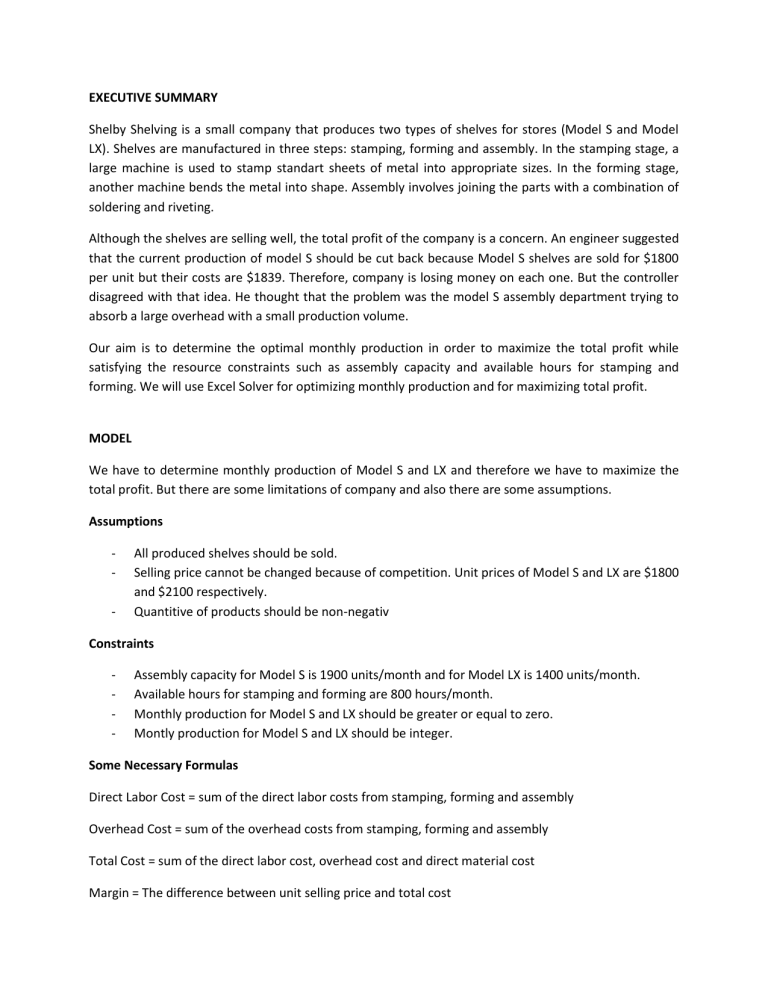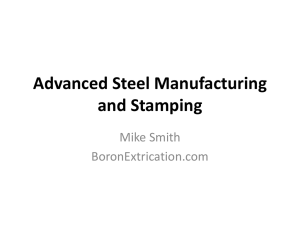
EXECUTIVE SUMMARY Shelby Shelving is a small company that produces two types of shelves for stores (Model S and Model LX). Shelves are manufactured in three steps: stamping, forming and assembly. In the stamping stage, a large machine is used to stamp standart sheets of metal into appropriate sizes. In the forming stage, another machine bends the metal into shape. Assembly involves joining the parts with a combination of soldering and riveting. Although the shelves are selling well, the total profit of the company is a concern. An engineer suggested that the current production of model S should be cut back because Model S shelves are sold for $1800 per unit but their costs are $1839. Therefore, company is losing money on each one. But the controller disagreed with that idea. He thought that the problem was the model S assembly department trying to absorb a large overhead with a small production volume. Our aim is to determine the optimal monthly production in order to maximize the total profit while satisfying the resource constraints such as assembly capacity and available hours for stamping and forming. We will use Excel Solver for optimizing monthly production and for maximizing total profit. MODEL We have to determine monthly production of Model S and LX and therefore we have to maximize the total profit. But there are some limitations of company and also there are some assumptions. Assumptions - All produced shelves should be sold. Selling price cannot be changed because of competition. Unit prices of Model S and LX are $1800 and $2100 respectively. Quantitive of products should be non-negativ Constraints - Assembly capacity for Model S is 1900 units/month and for Model LX is 1400 units/month. Available hours for stamping and forming are 800 hours/month. Monthly production for Model S and LX should be greater or equal to zero. Montly production for Model S and LX should be integer. Some Necessary Formulas Direct Labor Cost = sum of the direct labor costs from stamping, forming and assembly Overhead Cost = sum of the overhead costs from stamping, forming and assembly Total Cost = sum of the direct labor cost, overhead cost and direct material cost Margin = The difference between unit selling price and total cost Total Profit = Margin of S*Quantity of S + Margin of LX*Quantity of LX OR Total Profit = sum of the profit of each Model - Fixed costs Total Time Required = sum of both model machine time requirement*Quantity Analysis of Model Let x and y represents the monthly production of Model S and Model LX respectively. 0.3x+0.3y ≤ 800 (Constraint available hours for stamping) 0.25x+0.5y ≤ 800 (Constraint available hours for forming) x ≤ 1900 and y ≤ 1400 (Constraints for monthly production of Model S and Model LX) x ≥ 0 and y ≥ 0 (Both monthly production should be an integer and ≥ zero) and we want to maximize our total profit which is (1800 - 1540)x + (2100 - 1855)y - 350.000 Unit Selling Price of S Direct Material Cost+Total Direct Labor Cost+Variable Cost for S Unit Selling Price of LX Fixed Cost Direct Material Cost+Total Direct Labor Cost+Variable Cost for LX So, it is 260x + 245y - 350.000 CONCLUSION & INTERPRETATION The calculation has proven that contribution margin of Model S is higher than Model LX. In conclusion, all resources should be allocated to produce Model S up to its maximum production capacity. In order to maximize the total profit, the monthly production plan should be 1900 unit/month for Model S and 650 unit/month for Model LX. After arranging these optimal values by using “solver”, the total profit would be $268,250 as you can see in Appendix II. So, we can see that the engineer’s idea is wrong because he wanted to reduce the monthly production of Model S in order to reduce lost per unit. If we reduce the monthly production of Model S, the total cost of S will raise and it will reduce the total profit. By determining the Model S maximum, the production will cover fixed costs, we will minimize our lost and therefore, total profit raises automatically.
![Shelby Shelving[1] Shelby Shelving is a small company that](http://s3.studylib.net/store/data/007776893_2-6e6cb76564b1714bdab569d40a809fdb-300x300.png)


